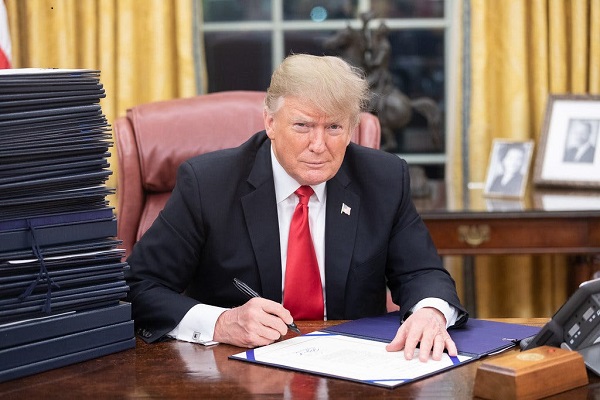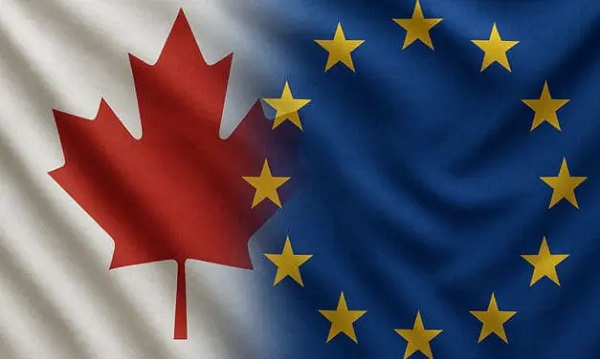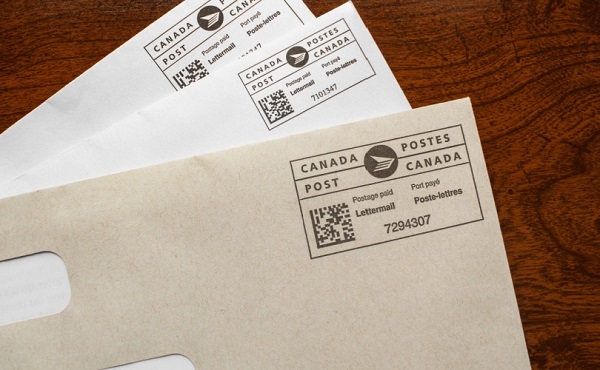Business
Trump announces “fair and reciprocal” tariffs, warning days of trade abuse are “over”

Quick Hit:
President Donald Trump on Thursday signed a memorandum directing his administration to implement a “fair and reciprocal” trade policy, ensuring that foreign nations imposing high tariffs on American goods will face identical treatment. In a statement on Truth Social, Trump declared that the days of the U.S. being economically exploited are over, vowing to retaliate against trade policies that unfairly disadvantage American businesses.
Key Details:
-
Trump wrote on Truth Social, “For purposes of fairness, I will charge a RECIPROCAL Tariff meaning, whatever Countries charge the United States of America, we will charge them—No more, no less!”
-
The policy will consider Value-Added Tax (VAT) systems—widely used in Europe—as trade barriers equivalent to tariffs, with Trump arguing they are “far more punitive” and used to harm American exports.
-
The administration will crack down on trade loopholes, including countries shipping goods through third-party nations to evade tariffs. “Sending merchandise, product, or anything by any other name through another Country, for purposes of unfairly harming America, will not be accepted,” Trump warned.
Diving Deeper:
Trump’s reciprocal tariff plan is designed to end decades of one-sided trade deals that he says have crippled American industries and workers. By enforcing equal tariffs on foreign nations, Trump is making it clear: If a country charges the U.S. high tariffs, they will face the same in return.
Trump specifically called out countries that manipulate Value-Added Tax (VAT) systems, arguing that these taxes function as hidden trade barriers designed to punish U.S. exports while protecting foreign industries. He declared, “For purposes of this United States Policy, we will consider Countries that use the VAT System, which is far more punitive than a Tariff, to be similar to that of a Tariff.”
Beyond traditional tariffs, Trump’s administration is also cracking down on non-monetary trade barriers, such as regulations designed to block American businesses from competing fairly overseas. He emphasized, “Provisions will be made for Nonmonetary Tariffs and Trade Barriers that some Countries charge in order to keep our product out of their domain or, if they do not even let U.S. businesses operate.”
Additionally, Trump warned against countries attempting to game the system by shipping goods through third-party nations to avoid tariffs. “Sending merchandise, product, or anything by any other name through another Country, for purposes of unfairly harming America, will not be accepted,” he stated.
Critics, including some business groups and investors, argue that tariffs could increase costs for U.S. consumers, but Trump’s supporters say securing fair trade is worth any short-term disruption. JPMorgan CEO Jamie Dimon defended the approach, stating, “If it’s a little inflationary but it’s good for national security, so be it. I mean, get over it.”
Meanwhile, Federal Reserve Chair Jerome Powell sidestepped questions about the policy but acknowledged that trade barriers could influence economic conditions, saying, “It’s not the Fed’s job to make or comment on tariff policy. That’s for elected people.”
Business
Carney’s European pivot could quietly reshape Canada’s sovereignty

This article supplied by Troy Media.
Canadians must consider how closer EU ties could erode national control and economic sovereignty
As Prime Minister Mark Carney attempts to deepen Canada’s relationship with the European Union and other supranational institutions, Canadians should be asking a hard question: how much of our national independence are we prepared to give away? If you want a glimpse of what happens when a country loses control over its currency, trade and democratic accountability, you need only look to Bulgaria.
On June 8, 2025, thousands of Bulgarians took to the streets in front of the country’s National Bank. Their message was clear: they want to keep the lev and stop the forced adoption of the euro, scheduled for Jan. 1, 2026.
Bulgaria, a southeastern European country and EU member since 2007, is preparing to join the eurozone—a bloc of 20 countries that share the euro as a common currency. The move would bind Bulgaria to the economic decisions of the European Central Bank, replacing its national currency with one managed from Brussels and Frankfurt.
The protest movement is a vivid example of the tensions that arise when national identity collides with centralized policy-making. It was organized by Vazrazdane, a nationalist, eurosceptic political party that has gained support by opposing what it sees as the erosion of Bulgarian sovereignty through European integration. Similar demonstrations took place in cities across the country.
At the heart of the unrest is a call for democratic accountability. Vazrazdane leader Konstantin Kostadinov appealed directly to EU leaders, arguing that Bulgarians should not be forced into the eurozone without a public vote. He noted that in Italy, referendums on the euro were allowed with support from less than one per cent of citizens, while in Bulgaria, more than 10 per cent calling for a referendum have been ignored.
Protesters warned that abandoning the lev without a public vote would amount to a betrayal of democracy. “If there is no lev, there is no Bulgaria,” some chanted. For them, the lev is not just a currency: it is a symbol of national independence.
Their fears are not unfounded. Across the eurozone, several countries have experienced higher prices and reduced purchasing power after adopting the euro. The loss of domestic control over monetary policy has led to economic decisions being dictated from afar. Inflation, declining living standards and external dependency are real concerns.
Canada is not Bulgaria. But it is not immune to the same dynamics. Through trade agreements, regulatory convergence and global commitments, Canada has already surrendered meaningful control over its economy and borders. Canadians rarely debate these trade-offs publicly, and almost never vote on them directly.
Carney, a former central banker with deep ties to global finance, has made clear his intention to align more closely with the European Union on economic and security matters. While partnership is not inherently wrong, it must come with strong democratic oversight. Canadians should not allow fundamental shifts in sovereignty to be handed off quietly to international bodies or technocratic elites.
What’s happening in Bulgaria is not just about the euro—it’s about a people demanding the right to chart their own course. Canadians should take note. Sovereignty is not lost in one dramatic act. It erodes incrementally: through treaties we don’t read, agreements we don’t question, and decisions made without our consent.
If democracy and national control still matter to Canadians, they would do well to pay attention.
Isidoros Karderinis was born in Athens, Greece. He is a journalist, foreign press correspondent, economist, novelist and poet. He is accredited by the Greek Ministry of Foreign Affairs as a foreign press correspondent and has built a distinguished career in journalism and literature.
Troy Media empowers Canadian community news outlets by providing independent, insightful analysis and commentary. Our mission is to support local media in helping Canadians stay informed and engaged by delivering reliable content that strengthens community connections and deepens understanding across the country.
Business
EU investigates major pornographic site over failure to protect children

From LifeSiteNews
Pornhub has taken down 91% of its images and videos and a huge portion of the last 9% will be gone by June 30 because it never verified the age or consent of those in the videos.
Despite an aggressive PR operation to persuade lawmakers that they have reformed, Pornhub is having a very bad year.
On May 29, it was reported that the European Commission is investigating the pornography giant and three other sites for failing to verify the ages of users.
The investigation, which comes after a letter sent to the companies last June asking what measures they have taken to protect minors, is being carried out under the Digital Services Act. The DSA came into effect in November 2022 and directs platforms to ensure “appropriate and proportionate measures to ensure a high level of privacy, safety, and security of minors, on their service” and implement “targeted measures to protect the rights of the child, including age verification and parental control tools, tools aimed at helping minors signal abuse or obtain support, as appropriate.”
According to France24: “The commission, the EU’s tech regulator, accused the platforms of not having ‘appropriate; age verification tools to prevent children from being exposed to pornography. An AFP correspondent only had to click a button on Tuesday stating they were older than 18 without any further checks to gain access to each of the four platforms.”
Indeed, Pornhub’s alleged safety mechanisms are a sick joke, and Pornhub executives have often revealed the real reason behind their opposition to safeguards: It limits their traffic.
Meanwhile, Pornhub — and other sites owned by parent company Aylo — are blocking their content in France in response to a new age verification law that came into effect on June 7. Solomon Friedman, Aylo’s point man in the Pornhub propaganda war, stated that the French law was “potentially privacy infringing” and “dangerous,” earning a scathing rebuke from France’s deputy minister for digital technology Clara Chappaz.
“We’re not stigmatizing adults who want to consume this content, but we mustn’t do so at the expense of protecting our children,” she said, adding later, “Lying when one does not want to comply with the law and holding others hostage is unacceptable. If Aylo would rather leave France than apply our law, they are free to do so.” According to the French media regulator Arcom, 2.3 million French minors visit pornographic sites every month.
Incidentally, anti-Pornhub activist Laila Mickelwait reported another major breakthrough on June 7. “P*rnhub is deleting much of what’s left of the of the site by June 30,” she wrote on X. “Together we have collectively forced this sex trafficking and rape crime scene to take down 91% of the entire site, totaling 50+ million videos and images. Now a significant portion of the remaining 9% will be GONE this month in what will be the second biggest takedown of P*rnhub content since December 2020.”
“The reason for the mass deletion is that they never verified the age or consent of the individuals depicted in the images and videos, and therefore the site is still awash with real sexual crime,” she added. “Since the fight began in 2020, 91% of P*rnhub has been taken down — over 50 million images and videos. Now a huge portion of the last 9% will be gone by June 30 because P*rnhub never verified the age or consent of those in the videos and the site is a crime scene.”
Mickelwait has long called for the shutdown of Pornhub and the prosecution of those involved in its operation. This second mass deletion of content, as welcome as it is, reeks of a desperate attempt to eliminate the evidence of Pornhub’s crimes.
-

 Crime1 day ago
Crime1 day agoHow Chinese State-Linked Networks Replaced the Medellín Model with Global Logistics and Political Protection
-

 Aristotle Foundation2 days ago
Aristotle Foundation2 days agoWe need an immigration policy that will serve all Canadians
-

 Addictions2 days ago
Addictions2 days agoNew RCMP program steering opioid addicted towards treatment and recovery
-

 Business1 day ago
Business1 day agoNatural gas pipeline ownership spreads across 36 First Nations in B.C.
-

 Business14 hours ago
Business14 hours agoEU investigates major pornographic site over failure to protect children
-

 Courageous Discourse1 day ago
Courageous Discourse1 day agoHealthcare Blockbuster – RFK Jr removes all 17 members of CDC Vaccine Advisory Panel!
-

 Health1 day ago
Health1 day agoRFK Jr. purges CDC vaccine panel, citing decades of ‘skewed science’
-

 Censorship Industrial Complex1 day ago
Censorship Industrial Complex1 day agoConservatives slam Liberal bill to allow police to search through Canadians’ mail



